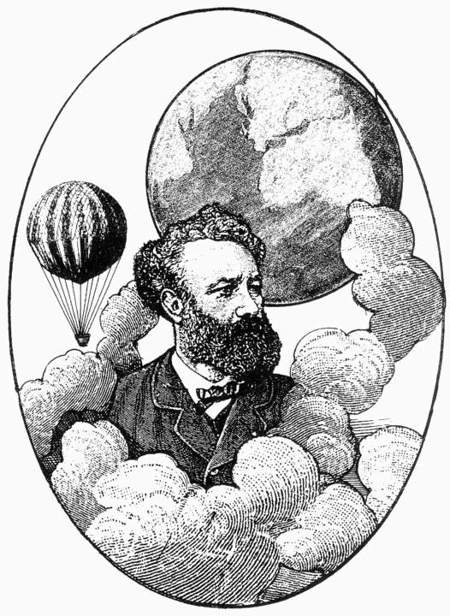Journey Through the Impossible (27 page)
Read Journey Through the Impossible Online
Authors: Jules Verne,Edward Baxter

18. Verne was always in favor of what is today called the environment.
Without being a "green environmentalist" (the concept didn't exist at his time),
he envisioned that the mining of energy sources would impoverish the earth. In
A Floating City (chap. 39), he writes: "Here we had a last view of the magnificent Niagara cataract. Our companion observed it with a thoughtful air.
" `Isn't it grand, sir? Isn't it magnificent?' I said to him.
" `Yes,' he replied; `but what a waste of mechanical force, and what a mill
might be turned with a fall as that!'
"Never did I feel more inclined to pitch an engineer into the water!"
19. The dialogue between Volsius and Ox confirms Verne's doubts
about science and religion in the middle of his life (he was fifty-four in 1882).
Volsius, spokesman of Verne, makes the first step toward Ox and asks him to
use his science in a positive way. Ox and Volsius, the doctor and the priest,
save George Hatteras from insanity and bring the play to a happy end.
APPENDIX
NOTES TO THE
ARNOLD 7VORTIER REVIEW
1. A theater built in Paris, on the boulevard St-Martin, in 1781. Still in
use today.
2. Adolphe Philippe (1811-1899), French playwright who used the
pseudonyms of Dennery and d'Ennery. He wrote melodramas and opera
libretti. His best-known work is The Two Orphans (Les deux orphelines). His
wife's collection of oriental art belongs to the French nation and can still be
seen today in the Musee d'Ennery in Paris.
3. Pseudonym of Paul Collin (1840-1906), director of the Theatre de
la Porte St-Martin 1879-1883.
4. Paul-Felix Taillade (182 6-1898), French actor, who also performed
in The Children of Captain Grant (Les Enfants du capitaine Grant).
5. Theatre de l'Ambigu, one of the best-known theaters in Paris in the
nineteenth century.
6. Joseph-Francois Dailly (1839-1897), French actor who created the
role of Passepartout in Around the World in Eighty Days and plays Valdemar
in journey Through the Impossible.
7. A park in Paris. In December 1769 the Duke of Chartres bought a
parcel of land a little more than one hectare (2.5 acres), which was the starting
point of the future Monceau Park. He then increased the area by twelve
hectares, to create a place for festivals and recreation. The park changed
owners during the Revolution and the Restoration, and in 1860 became the
property of the city of Paris, preserving half of its area as of that time. Its current configuration was inaugurated in August 1861 by Napoleon III.
8. Born in Bordeaux in 1853, Oscar-Louis-Antoine-Ferdinand de
Lagoanere was a prolific and successful composer and conductor. In the
1880s he became director of the Theatre des Menus-Plaisirs and later of the
Theatre des Bouffes-Parisiens. His last known work was published in 1907.
Nothing is known about him after that date.
9. Auguste Rube (1815-1899).
10. Philippe-Marie Chaperon (1823-1907).
11. A play on the French word "joailleur" (jeweller) and the city of Goa
in India.
12. Francois Rene de Chateaubriand was a French writer born in SaintMalo in 1786. He died in Paris in 1848.
13. French port on the Atlantic coast of Brittany. Its 50,000 inhabitants
are known as "Malouins." During the fifteenth, seventeenth, and eighteenth
centuries Saint-Malo was the home town of many seamen and corsairs.
Chateaubriand's best-known portrait depicts him sitting on a rock in SaintMalo, facing the Atlantic Ocean. Arnold Mortier uses this well-known icon
to convey his impression of Taillade, as Doctor Ox, standing on the Nautilus,
which looks to him like a rock.
14. Pseudonym of Gaspard-Felix Tournachon (April 5, 1820-March 21,
1910), a French writer, caricaturist, and photographer who is remembered
primarily for his photographic portraits, which are considered to be among
the best from the nineteenth century. He was one ofJules Verne's best friends.
15. A cathedral in Paris. A gothic masterpiece, Notre-Dame de Paris
was conceived by Maurice de Sully and built between the twelfth and fourteenth centuries (1163-1345). Road distances in France are calculated on the
basis of the "0 km" marked on the square in front of the cathedral.
NOTES TO THE
NOW YORK TI1'IES REVIe i
1. Written Eva in the play. The role was played by the French actress
Marie Daubrun (1828-1901), who appeared on stage for the last time in 1889.
Marie Daubrun was Baudelaire's mistress and inspired several of his poems.
2. An opera by Charles Gounod (1818-1893), performed in the Opera
of Paris, April 1, 1881.
3. A French actor born in 1814, Augustin-Guillemet Alexandre also
played in Around the World in Eighty Days and Tartelet in journey Through the
Impossible.
4. The unknown reviewer is confusing Sweden and Denmark. In the
play, Valdemar is a Dane.
5. An opera by Georges Bizet (1838-1875), performed in the OperaComique in Paris, March 3, 1875.
6. Pauline Party, a French actress whose true name was Jeanne Cecile
Pauline Pesty, began her career in 1873. She died in 1910.


